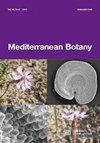Pamvotis湖(Epirus,希腊西北部)保护区的植物群落和栖息地类型
IF 0.7
4区 生物学
Q3 PLANT SCIENCES
引用次数: 1
摘要
根据理事会第92/43/EEC号指令,对帕姆沃蒂斯湖(Epirus,希腊西北部)保护区的植被进行了研究,并将其划分为栖息地类型。Ioannina盆地和Mt Mitsikeli西南部的主要植被类型为:(1)球栎灌木林,(2)退化的落叶橡树林,(3)带Juniperus的地中海树状毛白杨,(4)Oro-Mediterranean石南地,(5)柳树低开放林,(8)水生大型植物群落,(9)芦苇床和灯心草草甸。鉴定出20个植物群落,分属12个联盟、11个目和10个植物社会学类别。Asplenio ceterach Aurinietum saxatilae被描述为一个新的协会,Eleocharito palustris Alismatetum lanceolati是希腊首次报道。确定了11种栖息地类型,并对其保护状况进行了评估。三种栖息地类型(40908210,91M0)处于有利的保护状态,而一种(5210)处于不利的恶劣保护状态。其余地区处于不利的保护不足状态,记录了一些压力和威胁。本文章由计算机程序翻译,如有差异,请以英文原文为准。
Plant communities and habitat types in the protected area of Lake Pamvotis (Epirus, Northwestern Greece)
The vegetation of the protected area of Lake Pamvotis (Epirus, NW Greece) was studied and classified into habitat types according to the Council Directive 92/43/EEC. The main vegetation types encountered in the Ioannina Basin and the south-western part of Mt Mitsikeli are: (1) Quercus coccifera shrublands, (2) degraded deciduous oak forests, (3) Mediterranean arborescent mattorals with Juniperus, (4) Oro-Mediterranean heathlands, (5) willow low open forests, (6) οriental plane woods, (7) plant communities supported by calcareous substrates, (8) aquatic macrophyte assemblages, (9) reed beds and rush meadows. Twenty plant communities belonging to twelve alliances, eleven orders, and ten phytosociological classes were discerned. The Asplenio ceterach-Aurinietum saxatilae is described as a new association and the Eleocharito palustris-Alismatetum lanceolati is reported for the first time from Greece. Eleven habitat types were identified and their conservation status was assessed. Three habitat types (4090, 8210, 91M0) were in favourable conservation status, while one (5210) is in unfavourable-bad conservation status. The rest are in unfavourable-inadequate conservation status, with several pressures and threats recorded.
求助全文
通过发布文献求助,成功后即可免费获取论文全文。
去求助
来源期刊

Mediterranean Botany
Agricultural and Biological Sciences-Plant Science
CiteScore
2.40
自引率
10.00%
发文量
30
审稿时长
12 weeks
期刊介绍:
Mediterranean Botany (ISSNe 2603-9109), formerly Lazaroa, is a biannual journal that publishes original research studies in the field of Botany including plant systematics, vegetation ecology, biogeography, evolutionary biology, ecophysiology, community ecology, ethnobotany and conservation biology on Mediterranean biomes but also in interacting areas.
Mediterranean Botany is an OPEN ACCESS Journal, free of charges for any published article.
 求助内容:
求助内容: 应助结果提醒方式:
应助结果提醒方式:


